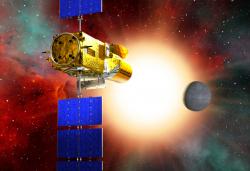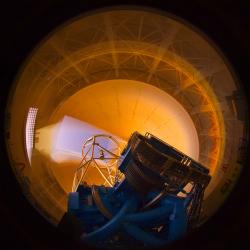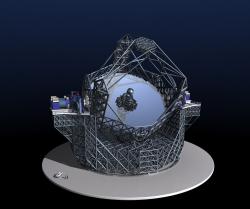 Step aside Hubble, Chandra, Spitzer, there’s a new space telescope ready for launch. On December 27, 2006, the European Space Agency is planning to launch its planet hunting, starquake finding COROT satellite.
Step aside Hubble, Chandra, Spitzer, there’s a new space telescope ready for launch. On December 27, 2006, the European Space Agency is planning to launch its planet hunting, starquake finding COROT satellite.
Continue reading “Next Up, the COROT Space Telescope”
Gallery of the Gemini North Telescope
 I know we normally like to see pictures taken by telescopes, but here’s cool set of pictures of telescopes. Okay, it’s actually several pictures of one telescope, the Gemini North telescope, located atop Hawaii’s Mauna Kea volcano. The timelapse photographs were all taken during a single night of telescope operations.
I know we normally like to see pictures taken by telescopes, but here’s cool set of pictures of telescopes. Okay, it’s actually several pictures of one telescope, the Gemini North telescope, located atop Hawaii’s Mauna Kea volcano. The timelapse photographs were all taken during a single night of telescope operations.
Continue reading “Gallery of the Gemini North Telescope”
Studies Will Proceed on Extremely Large Telescope
 The European Southern Observatory’s governing body has agreed to proceed with detailed studies for a new, Extremely Large Telescope. The study alone has a budget of 57 million euros, and should lead to the beginning of construction in 3 years. If everything goes well, the ELT will become the world’s largest telescope, spanning 42 metres. It will have 100 times more light-gathering capacity than the largest current telescopes. The final cost will probably be more than 800 million euros.
The European Southern Observatory’s governing body has agreed to proceed with detailed studies for a new, Extremely Large Telescope. The study alone has a budget of 57 million euros, and should lead to the beginning of construction in 3 years. If everything goes well, the ELT will become the world’s largest telescope, spanning 42 metres. It will have 100 times more light-gathering capacity than the largest current telescopes. The final cost will probably be more than 800 million euros.
Continue reading “Studies Will Proceed on Extremely Large Telescope”
Enhanced Vision for the Subaru Telescope
The Subaru telescope has been equipped with a new adaptive optics system that has enhanced its already impressive vision by a factor of 10. The new system uses a laser beam to project an artificial guide star into the sky at an altitude of 90 km. Computers can then calculate the distortions from the Earth’s atmosphere and adjust the shape of a special mirror to remove those distortions.
Continue reading “Enhanced Vision for the Subaru Telescope”
New Telescope Will Search for Asteroids and Map Out the Universe
A newly built observatory on Maui is getting ready to release a flood of astronomical data. The 1.8 metre Pan-STARRS telescope will perform an automated search for asteroids that threaten the Earth. While it’s searching for asteroids, the telescope will also build up one of the most detailed maps of our surrounding Universe. Researchers will use this data to create a 3-dimensional map of galaxies and dark matter, and measure the properties of the dark energy accelerating the expansion of the Universe.
Continue reading “New Telescope Will Search for Asteroids and Map Out the Universe”
Giant Radio Telescope May Go to Australia or Africa
Australia and South Africa have been shortlisted to host the Square Kilometer Array, a massive radio telescope that will be built in 2018. The array will have thousands of antennas, spread out over an area of 3,000 km (1,800 miles), and should be 50 times more powerful than the most powerful array of radio telescopes we have today. The Australian site will be near Meekathara in the western side of the country, while the South African site will be near Carnarvon. Both sites were chosen because of the low interference of man-made radio signals in the surrounding countryside.
Continue reading “Giant Radio Telescope May Go to Australia or Africa”
Radio Telescope Will Look Back to the Beginning
The Mileura Widefield Array – Low Frequency Demonstrator was awarded $4.9 million in funding from the National Science Foundation this week. A prototype of this radio telescope is being constructed in the Australian outback, away from radio interference. Once completed, the telescope will consist of 500 tiles – each of which contains 16 radio antennas. The observatory will look back to the earliest Universe, when there was only dark matter and primordial hydrogen. It should be able to see the first patches of higher density, as this gas pulled together to form the first stars and galaxies.
Continue reading “Radio Telescope Will Look Back to the Beginning”
Sky Shade Could Reveal Planets
Space telescopes designed to observe distant planets need to be powerful, but they also need some method of blocking the light from the parent star, which completely washes out any dimmer objects orbiting it. A strategy from CU-Boulder professor Webster Cash would use a large, daisy-shaped space shield to block the light from the star. A space telescope trailing the shade by thousands of kilometres would then be able to see much fainter objects surrounding the star.
Continue reading “Sky Shade Could Reveal Planets”
The Clearest Skies on Earth
Telescopes are perched at the tops of mountains because the air up there is thinner, drier and clearer than the view from sea level. But the best views of all are near the south pole in Antarctica, in a region called Dome C. With its high altitude, low temperatures, and crystal clear skies, Dome C boasts nearly perfect viewing conditions. A team of French astronomers are hoping to build a trio of telescopes that work together as a single, large telescope as a prototype. But they’ve got their sights set on a larger installation that could rival the capabilities of the best telescopes on Earth. It’s all about location, location, location.
Continue reading “The Clearest Skies on Earth”
Airship Observatories Could Give the Best View
When it comes to astronomy, large telescopes rule. But if you can get your instrument into space, you bypass the atmosphere that blurs sensitive data. Unfortunately, the cost of launching observatories into space is beyond the budget of most researchers. One possible strategy is to install powerful observatories instruments onto high altitude airships, which can float above most of obscuring atmosphere. The view from the high atmosphere is almost as good as actually being in orbit, and it can be had for a fraction of the price of flying a telescope into orbit.
Continue reading “Airship Observatories Could Give the Best View”
